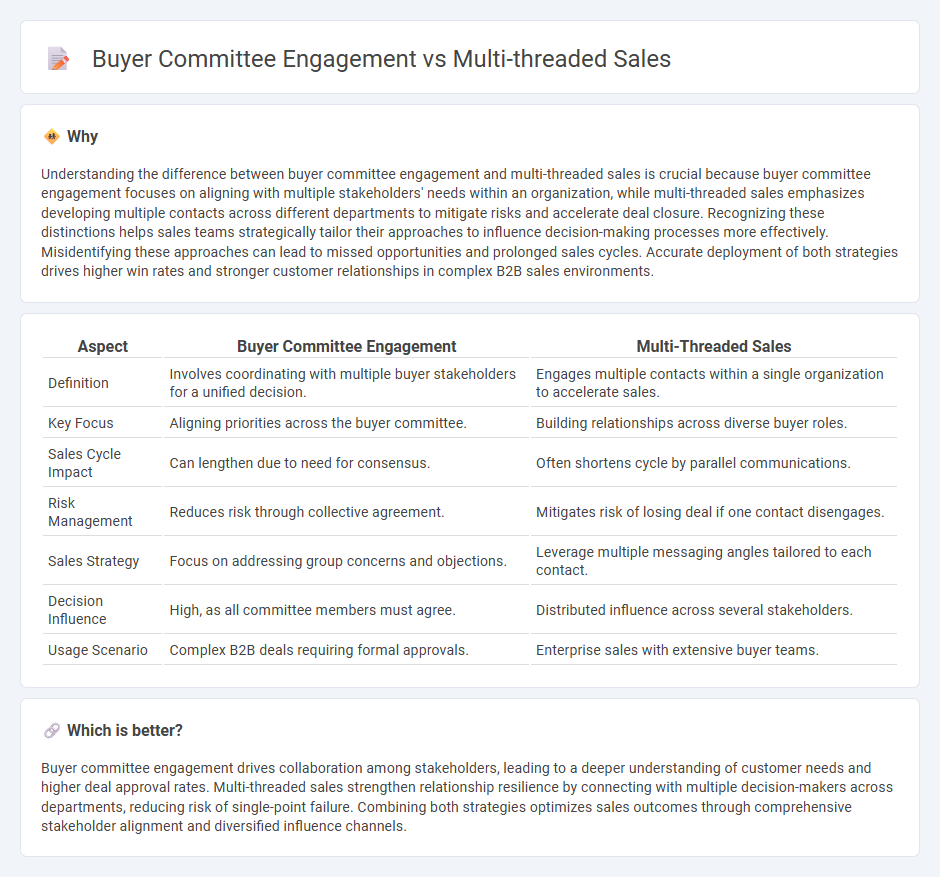
Buyer committee engagement focuses on building consensus among key decision-makers within the client organization to secure commitment and ensure alignment throughout the sales process. Multi-threaded sales involve cultivating multiple relationships across different roles and departments to reduce risks associated with single points of contact and increase the likelihood of deal closure. Explore strategies to optimize your sales approach by understanding the distinctions and benefits of both methods.
Why it is important
Understanding the difference between buyer committee engagement and multi-threaded sales is crucial because buyer committee engagement focuses on aligning with multiple stakeholders' needs within an organization, while multi-threaded sales emphasizes developing multiple contacts across different departments to mitigate risks and accelerate deal closure. Recognizing these distinctions helps sales teams strategically tailor their approaches to influence decision-making processes more effectively. Misidentifying these approaches can lead to missed opportunities and prolonged sales cycles. Accurate deployment of both strategies drives higher win rates and stronger customer relationships in complex B2B sales environments.
Comparison Table
| Aspect | Buyer Committee Engagement | Multi-Threaded Sales |
|---|---|---|
| Definition | Involves coordinating with multiple buyer stakeholders for a unified decision. | Engages multiple contacts within a single organization to accelerate sales. |
| Key Focus | Aligning priorities across the buyer committee. | Building relationships across diverse buyer roles. |
| Sales Cycle Impact | Can lengthen due to need for consensus. | Often shortens cycle by parallel communications. |
| Risk Management | Reduces risk through collective agreement. | Mitigates risk of losing deal if one contact disengages. |
| Sales Strategy | Focus on addressing group concerns and objections. | Leverage multiple messaging angles tailored to each contact. |
| Decision Influence | High, as all committee members must agree. | Distributed influence across several stakeholders. |
| Usage Scenario | Complex B2B deals requiring formal approvals. | Enterprise sales with extensive buyer teams. |
Which is better?
Buyer committee engagement drives collaboration among stakeholders, leading to a deeper understanding of customer needs and higher deal approval rates. Multi-threaded sales strengthen relationship resilience by connecting with multiple decision-makers across departments, reducing risk of single-point failure. Combining both strategies optimizes sales outcomes through comprehensive stakeholder alignment and diversified influence channels.
Connection
Buyer committee engagement enhances multi-threaded sales by involving multiple decision-makers, which increases communication channels and touchpoints across an organization. Multi-threaded sales leverage diverse relationships within the buyer committee to mitigate risks associated with single points of contact, improving deal velocity and closure rates. Effective coordination among buyer committee members empowers sales teams to tailor messaging and address varied stakeholder priorities, driving higher conversion success.
Key Terms
Stakeholder Mapping
Effective stakeholder mapping enhances multi-threaded sales by identifying and engaging all key members of the buyer committee early in the sales process. Understanding roles, influence, and decision-making dynamics within the buyer committee allows sales teams to tailor communications and strategies, increasing the likelihood of deal success. Explore advanced stakeholder mapping techniques to optimize buyer committee engagement and drive superior sales outcomes.
Decision-Making Unit (DMU)
Multi-threaded sales strategies target various members within the Decision-Making Unit (DMU) to enhance buyer committee engagement and accelerate complex purchase decisions. Engaging multiple stakeholders simultaneously fosters alignment, streamlines communication, and increases the likelihood of consensus among influencers, gatekeepers, and decision-makers. Explore how optimizing DMU interactions can drive more effective sales outcomes and higher conversion rates.
Champion Development
Effective multi-threaded sales strategies emphasize comprehensive buyer committee engagement by identifying and nurturing key decision-makers, particularly champions who drive internal consensus. Developing strong relationships with champions accelerates deal progress by leveraging their influence and insights throughout complex purchasing processes. Explore detailed methods to enhance champion development and optimize multi-threaded sales success.
Source and External Links
What is Multithreading Sales? - DealHub - Multi-threaded sales is a strategy where multiple salespeople engage simultaneously with multiple stakeholders in the buying organization, improving deal coverage, building relationships, and increasing chances of closing complex or large deals faster.
Multithreading Sales: Guide to Closing Big Deals Fast - Cognism - This approach involves connecting with multiple decision-makers across departments to handle complex, high-stakes deals by addressing diverse stakeholder concerns simultaneously, thereby accelerating the sales process and improving conversion rates.
Sales Multi-Threading: 11 Proven Strategies for 2025 | pclub.io - Multi-threading is essential for modern B2B sales where deals involve many decision-makers; tactical multi-threaded strategies help sellers map stakeholder influence, align around shared outcomes, and increase win rates with faster deal velocity.
 dowidth.com
dowidth.com